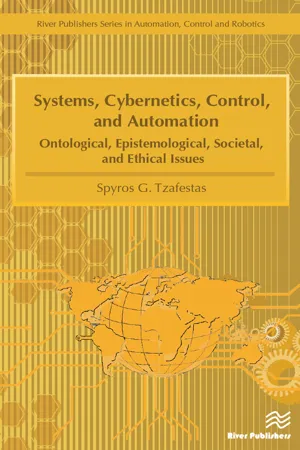Technology & Engineering
Automation
Automation refers to the use of technology and machinery to perform tasks with minimal human intervention. It involves the creation and application of systems that can operate and control processes, reducing the need for manual labor. Automation aims to improve efficiency, accuracy, and productivity in various industries by streamlining repetitive tasks and enabling the execution of complex operations.
Written by Perlego with AI-assistance
Related key terms
3 Key excerpts on "Automation"
- eBook - ePub
- Spyros G. Tzafestas(Author)
- 2022(Publication Date)
- River Publishers(Publisher)
2 ]. Actually, many different definitions of Automation have been proposed. Some of them are the following:- Dunlop [3 ]: Automation is defined as a mechanical or chemical process directed, controlled, and corrected within the limits such that no human intervention is needed once a system is established.
- Thomas [4 ]: Level of Automation is defined as the extent to which decision making functions associated with control of a man/machine system are performed by machines.
- Dieterly [5 ]: Automation is the operation of a system or production process by mechanical or electronic devices that takes the worker’s place in terms of effort, observation, and decision-making.
The last definition is an integration of various other definitions of Automation. As pointed out by many authors, this definition does not differentiate between mechanization and Automation. These authors point out the fact that mechanization includes only the machine performing tasks which do not require decision making, whereas the concept of Automation includes the machine performing tasks that need decision-making.The principal goal of Automation is the optimal allocation of human effort (muscular, mental) so as to maximize the productivity, i.e., the ratio of the product obtained over the human effort needed to do this. Today, the term Automation is used in all situations where the system operation is automated to various degrees. The operation of the system is usually performed in a sequential or parallel multi-stage manner.Computerized systems, with terminals, displays, sensors, and other human-computer interfaces are now considered as part of Automation (even if they do only processing, and not control or supervision). The system in which the operation is to be automated can be any man-made systems (physical, chemical, electrical/electronic, managerial, etc.). An overall self-explained pictorial representation of an Automation system which shows how the above concepts and ideas can be integrated is given in Figure 8.1 [6 - eBook - ePub
A Handbook of Work and Organizational Psychology
Volume 4: Organizational Psychology
- Charles, De, Wolff, P J D Drenth, THIERRY HENK(Authors)
- 2013(Publication Date)
- Psychology Press(Publisher)
- Computer Aided Manufacturing (CAM) in assembly—in particular, the programmable robot. At present, programmable robots are chiefly used to join parts of a product, as by welding. This is a relatively recent application of Automation to which much further refinement is needed—to the sensor systems, the control algorithms, the programmability, and the interfaces with other machines via the central computer.
- Automation of the physical distribution. Emphasis here lies on stock control and production control. Familiar examples are automated warehouses, automatically guided transport vehicles, and computer reports when stock levels become critical. An important development in this field is the linking of physical distribution systems to more general production control systems.
- Automation of control processes. These involve data processing, communication systems, and information systems at all three control levels (strategic, tactical, and operational). An important development in this field is Manufacturing Resource Planning (MRP), in which several elements have been combined with a view to optimal control and planning of the production process, so that materials and resources can be employed efficiently, ultimately to supply the products to the customer as planned. More and more information networks are also being set up between companies, to optimize the supply of products to customers and to minimize intermediate stocks. Co-makership between companies becomes a usual practice in trying to minimize losses in the whole chain of processes from raw materials to consumer.
All these types of Automation are used in industrial production systems. Automation of control processes at the three control levels is also employed in administrative information systems, such as budgeting systems, personnel information systems, and management-accounting information systems.Wentink and Zanders (1985) distinguished four types of office tasks: policy-making tasks, professional tasks, secretarial tasks, and administrative tasks. They differ from one another in the information subprocesses that make up the most important parts of the task. Examples of information subprocesses are: generating, handling, interpreting, recording, storing, retrieving, consulting, duplicating. Because they are of a more standardized and predictable nature, administrative and secretarial tasks are easier to automate than policy-making and professional tasks. The information subprocesses of interpretation and generation are among the main activities of the two latter types of tasks. This makes the application of computers more difficult, despite a growing interest in “expert systems”. Expert systems aim at the representation of the knowledge of a human expert. Very few expert systems are in use as yet, although in principle many semi-structured decision problems could be approached with the help of expert systems (Ballantine, 1988). If the user is unable to follow the decision-making process of the system, it is a considerable obstacle to the application of such systems. This is an essential condition: if the system is not able to explain its reasoning to the user, it will not be used. Another problem in the development of expert systems is specifying the knowledge. In other words, via what techniques can the knowledge be quantified? Methods have become available in recent years. Also in the field of management tasks automated information systems are being implemented, to support decision-making by managers. The adoption of these Executive Information Systems however is not so easy (see, e.g., Cullen, 1995). - eBook - ePub
- Gordon Mair(Author)
- 2019(Publication Date)
- Wiley(Publisher)
Part IV Manufacturing Automation 18 Manufacturing Automation – Introduction The topic of manufacturing Automation covers a broad spectrum and this short chapter focuses on the ‘what’ and ‘why’ of Automation. In the following three chapters, the individual building blocks of Automation are initially considered, then industrial robots as an exemplar of the topic and in Chapter 21 the operation of machine vision systems is examined as these are commonly found within many areas of industry. The word ‘automatic’, was derived from the Greek automaton meaning ‘acting independently’. Although it had been used earlier, the term ‘Automation’ came into common usage in the car industry in the early to mid‐twentieth century and it implies the concept of mechanisation with the added feature of automatic control. The term ‘mechanisation’ was a prominent aspect of the Industrial Revolution that began in the eighteenth century and it refers to the application of machinery to do work previously done by humans and horses and so on. Here, we will use the term ‘manufacturing Automation’ to encompass the equipment and techniques used not only to eliminate the need for human work, as with industrial robots, but also to assist the manufacturing process more generally. 18.1 Types of Automation Dedicated Automation is used for making high volumes of the same product at high production rates for long periods of time. The type of equipment used is sometimes called ‘hard’ Automation as it is purpose built to make a specific product and the physical structure and its control are not easily changed to produce different products. Reprogrammable, or ‘soft’ Automation refers to automatic processes or equipment that can be easily reprogrammed to cope with changes in products or tasks. This type is popular due to the short life cycles of many modern products and the need to satisfy a wide range of different customer demands
Learn about this page
Index pages curate the most relevant extracts from our library of academic textbooks. They’ve been created using an in-house natural language model (NLM), each adding context and meaning to key research topics.


